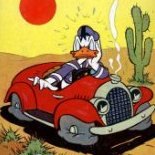-
Posts
206 -
Joined
-
Last visited
Plastheniker's Achievements

Established Member (3/9)
592
Reputation
-
Thanks for the response! As far as I remember Minicraft's TR 3 was originally made by Entex in the seventies (?), later sold to RoG. I saw it finished a few times and it is certainly no match to the Ganze Sangyo kit. If you want to build a TR 3 try to find the latter. BTW Gunze also offered a TR 2 with steel disc wheels, but only (I am not quite sure) as a High Tech version. IMO the finished TR 2 is not as attractive as the TR 3. As mentioned this was my last topic in BM. Thanks for your interest during the past years!
-
Hi, This is my last topic in BM. When reviewing my remaining subjects I thought choosing a classic British sports car would be appropriate. Maybe 25 years ago Gunze Sangyo produced two versions of the same 1/24 car kits: The first line was rather expensive. These kits were labeled “Gunze Sangyo High Tech Model”. They included fantastic PE wire wheels (if the 1:1 vehicle had wires) and a lot of other PE parts whose benefit, however, was mostly doubtful. IMO a really annoying set-back was the extensive use of cast pewter parts not only for the engine and the chassis but also for the exterior chrome parts (f. e. bumpers, door handles). It was extremely time-consuming giving them a smooth chrome-like appearance. Even worse, if you were unlucky your clear coat didn’t prevent these parts from darkening over the years. The second line were inexpensive all-plastic curbside versions of these “High Tech” kits. They came without pewter parts and without PE parts, but unfortunately also the fantastic PE wires were replaced by plastic spoke wheels. I bought only one “High Tech Model”. Taking its high price into account, I was completely annoyed despite the outstanding wheels. Overall IMO the all-plastic kits were the better choice. With some improvements, particularly with better wires, they made really nice models at reasonable prices. My model was made from such an all-plastic kit. After 20 or 25 years I only remember that I replaced the rather massive windscreen, and that I used bright wire instead of the cast mouldings on top of the fenders. As usual I made my own wire wheels and detailed the interior.
- 17 replies
-
- 28
-

-
Thanks for the comments! IMO accentuated panel lines don't look realistic. From my point of view there are two main reasons: - On real cars panel lines (f. e. door gaps) are usually not wider than 4mm. Thus panel lines on 1/24 models should be less than 0.2mm wide, but actually they are much wider. Filling them with dark paint makes this difference salient. Even worse panel line edges on models are more or less roundish, what makes accentuated panel lines look even wider (and sometimes varying). - In reality panel lines disappear when viewed from sharper angles. Accentuated panel lines, however, remain visible because they are very shallow. IMO the best way to rework panel lines (if necessary) is scribing them considerably deeper and sanding the body until their edges are really sharp. Admittedly my Gallardo was hard to beat on a German Autobahn, traction and roadholding were fantastic, and it looked spectacular, but nevertheless I was not really happy with it because IMO it had little to do with the term "sports car" (the same is true for most modern cars). Its extremely poor visibility, its width and the huge turning circle of the early Gallardos made it a nightmare on narrow streets, in cities and worst of all in hotel garages. No usable luggage space, most terrible seats, the impossibility to change into second gear (unless the gearbox was hot) and last but not least continuously minor technical troubles but no reasonable service network made my decision to sell this car rather easy. By comparison my successor car ( 2008 facelift Viper convertible), though undriveable on slippery roads, turned out to be a much better (fun) car for less money.
-
Hi, usually I have little interest in modeling modern cars unless I want a replica of one of my own (former) 1:1 cars. Soon after its German market introduction I bought this Gallardo in 2003 and kept it until 2008: The corresponding Fujimi kit was rather nice but I remember 3 shortcomings: - The hexagonal plastic mesh of the numerous apertures of the original car was replicated by massive clear plastic parts with faint raised hexagonal lines. IMO in a kit that expensive (as far as I remember about 10 years ago I paid 60 € instead of 20 € for usual ROG or Italeri kits) PE parts can be expected. Today PE aftermarket parts are available. - Inserting the side windows was difficult because there was almost no contact between glass parts and body. Every time I bent the lower sides of the body outwards to join body and chassis these fragile joints broke. - OOB stance and track width were unrealistic. Nevertheless IMO the finished model looks rather convincing.
- 8 replies
-
- 24
-

-
Hi, most of Heller's 1/24 car kits were released during the seventies. They can make really beautiful models but not in the fast and easy way of modern kits. All Heller kits I know have one common issue that makes assembly needlessly difficult and sometimes really enigmatic: Drawings of Heller's assembly instructions often give only a vague idea of the correct parts location, and Heller parts don't have the usual pins and holes. Therefore it is wise always to simulate the following assembly steps before gluing anything. Some Heller kits do not have separate glass parts for the side windows. Instead each side has one single clear part comprising door panels, windows and window frames. At first glance this seems to be a good idea because it is no longer necessary to use any glue near the windows. Actually, however, the disadvantages outweigh the advantages as soon as window frames are foiled. Then every first cut has to be perfect because every failed cutting attempt would leave conspicuous grooves on the windows. Moreover removing foiling residue from clear parts requires utmost caution, even more if household foil adhesive was used. And finally, making a half-open window for better visibility of the interior becomes very difficult. This particular Heller kit of the iconic Bugatti 50 T has two salient and rather incomprehensible shortcomings. If they are not tackled the finished model won't look very realistic: - The stance of most finished models is obviously wrong. Their front is so high and their rear is so low as if the trunk had been filled with concrete. For a realistic stance the upper edges of the chassis rails have to be exactly horizontal. - The characteristic alloy rims of the original 50 T look like this: Heller's rims, however, have only faint resemblance. Note that they haven't even a rim flange: Nevertheless I never saw a finished model with better rims. Making six more realistic rims is rather painstaking and time-consuming, but IMO the effort pays off even if the result is not absolutely perfect. Besides I remember some comperatively minor issues: - The original 50 T had cable-operated adjustable friction shock absorbers. The kit has simple one-piece parts without any details. Since the open front fenders of the finished model reveal them they should be detailed or replaced. - The same is true for the cable-operated front brakes. All details, i. e. levers, deflection rollers and cables, are omitted and should be added. - OOB some body details are either omitted (trunk hinges and trunk catches) or moulded (bonnet catches, door handles and door hinges) - The two lateral ventilation flaps, poorly simulated by raised panel lines, should be scribed - OOB the interior is rather simple, so a lot of detailing has to be done. The kit dashboard has large recesses at both ends. Even if probably correct on Heller's 1:1 reference car such a dashboard would be atypical for a 50 T. With these reservations Heller's 50 T can make a convincing replica that can sustain comparison with most modern models. It requires, however, more time, resilience and skills than modern kits.
- 4 replies
-
- 14
-

-

Scratchbuilt Ferrari 375MM ... another woodie.
Plastheniker replied to albergman's topic in Ready For Inspection - Vehicles
Spectacular! For someone with very limited woodworking skills like me it is hard to believe that such a shape can be made from wood to this perfection. -

Kraz 260 & Dozer DET 250 1:35
Plastheniker replied to Mikemc's topic in Ready For Inspection - Vehicles
Unusual models, fantastic work and weathering, all the more if considering the small scale! -

1/43 Alfa Romeo TZ2 - Model Factory Hiro
Plastheniker replied to Sabrejet's topic in Ready For Inspection - Vehicles
Who ever built a 1/43 car model knows that small scales require a lot of skills and a lot of effort to achieve such a convincing result. Excellent model! -
Both models look very promising, some more pictures would be great. Is their scale 1/24 or 1/32?
-

scania Hookloader in 1:24 Veolia
Plastheniker replied to richellis's topic in Ready For Inspection - Vehicles
Excellent work and very realistic pictures. -
Hi, today kit manufacturers treat the modeler with a particular interest in 1/24 and 1/25 European pre-war cars as an orphan. ICM's Opel Admiral is the only corresponding new release of the last years that I remember. Admittedly this is a very nice kit, but I doubt that modelers missed just an Opel kit most. Finally there is no other choice than adhering to the well-known and often obsolete kits from the sixties, seventies and eighties - unless you are lucky to find an inexpensive diecast that can be converted into a model that meets the standards of today's styrene kit modeling. Usually, however, rebuilding such inexpensive diecasts requires much more effort and different skills than building a styrene kit. One of those numberless iconic European pre-war cars that have never been (and most probably will never be) kitted is Alfa Romeo's 8C 2900. Alfa Romeo made only the chassis with drivetrain and running gear derived from their 1935 8C 35 Grand Prix (!) racer, and Italy's most renowned coachbuilders, mostly Touring, supplied various ravishing bodies for it. Some years ago I found an inexpensive 1/24 diecast replicating an 8C 2900B with Berlinetta coachwork by Touring. There are several very similar surviving 1:1 Touring cars, the best-known is displayed at the Museo Storico Alfa Romeo. The 1:1 Berlinetta Touring coachwork (this one is the museum car) looks like this: My diecast was made by Leo Models of Italy and seems to be OOP by this time. Considering its low price (appr. € 20.00) it offered a pretty good value for money, much better f. e. than the very poor Bburago model I rebuilt earlier: 1937 Bugatti 57 SC Atlantic http://www.britmodeller.com/forums/index.php?/topic/234954092-1937-bugatti-57sc-atlantic/ Compared to a well-built kit model, however, the original appearance of my Leo diecast must be called sub-standard, to say the least, but most important all proportions were perfect, and after stripping the paintwork the casting quality was not bad. Moreover as far as plastic was used all plastic parts were workable (probably ABS, opposite to the strange tough Bburago plastic). Anyway there was a lot of work to do. I still remember some of the major issues: - As most diecast models this one featured opening bonnet halves, doors and bootlid with visible huge cast hinges, varying gaps and unsatisfactory fit. Maybe the manufacturer's rather unattractive black paintwork was intended to make these shortcomings less conspicuous - The whole interior, particularly the dashboard, was extremely simplified - All glass parts if at all provided were unusable - The cast frames around the lateral windows were completely out of scale - The plastic wire wheels were extremely crude; making new wires was a challenge because they had to be delicate as well as sturdy because of the rather high model weight - Conspicuously there were only incomplete or even (I am not sure) no wheel wells at all - The characteristic narrow ventilation slots around the radiator grille were missing; adding them in scale was painstaking because of the rather hard diecast metal IMO despite the considerable sacrifice of time ( here I think appr. 300 hours) projects like these are always worth the effort because the results are more or less unique opposite to often seen kit models. Anyway the rebuilt model is still one of my favourite road car models:
- 9 replies
-
- 20
-

-

1966 Lotus Elan S3 (Emma Peel's Car)
Plastheniker replied to Plastheniker's topic in Ready For Inspection - Vehicles
Thanks for the replies! If anyone should consider to search the web for this or another available Gunze Sangyo kit some information about the High Tech or the plastic versions can be found here: 1965 Jaguar E-Type S1 4.2 OTS http://www.britmodeller.com/forums/index.php?/topic/235018555-1965-jaguar-e-type-s1-42-ots/ -

1/8 Nagano Kawasaki 750 H2
Plastheniker replied to Lee Chambers's topic in Ready For Inspection - Vehicles
A perfect illusion! Only the slightly thicker spokes tell that this is a model. -
Super clean work! I always wondered what happened to the riders of such extreme choppers when they encountered the first sharp bend ...





